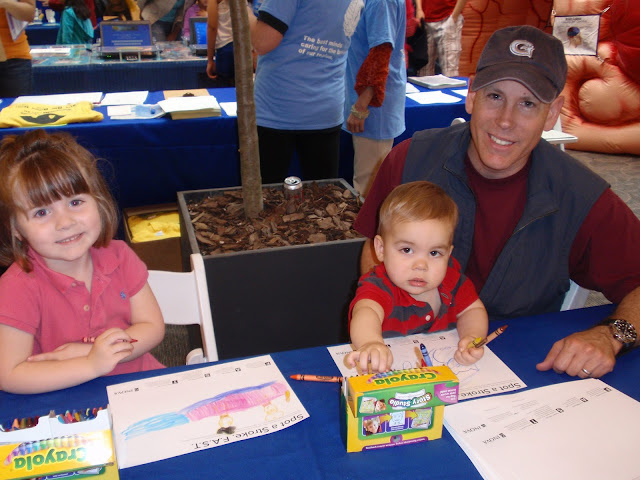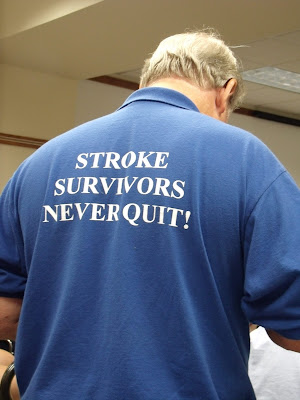Last Thursday, May 16th, I drove out to the Washington D.C. area from Peoria, Illinois to present the MegaBrain and our learning center, ELSIE, at the Stroke Month Megabrain Event hosted by Inova Neuroscience Institute held at the Tyson Corner Center Shopping Mall on May 18th. At last count, two thousand shoppers walked through the MegaBrain, visited the events stroke awareness displays, stroke risk assessment counselors and screening tables.
Forgive me for being a bad note taker. If you see any name corrections needed in this post, Karen and Joanna have my email address. I will make any corrections immediately.
Who Is Inova
I copied the following description of Inova off their website:
"Inova Neuroscience Institute is a regional leader in the diagnosis, treatment and research of complex neurological conditions involving the brain, spine and nervous system.
 With eight specialized programs, the Institute is the largest program of its kind in Northern Virginia. Our highly trained and nationally recognized physicians treat a wide range of conditions, including neurotrauma, spine conditions, brain and spinal tumors, memory disorders and stroke and cerebrovascular disease. Our comprehensive research program is committed to the advancement of treatment protocols.
With eight specialized programs, the Institute is the largest program of its kind in Northern Virginia. Our highly trained and nationally recognized physicians treat a wide range of conditions, including neurotrauma, spine conditions, brain and spinal tumors, memory disorders and stroke and cerebrovascular disease. Our comprehensive research program is committed to the advancement of treatment protocols.Inova Neuroscience Institute employs a multidisciplinary approach so that patients and their families experience expert, coordinated care from diagnosis through rehabilitation."
Karen Going and Joanna Fazio were my main contacts there and they helped me set up the MegaBrain Saturday morning and made sure throughout the day that I was doing OK. I appreciated that very much as I do need a lot of that reassurance during those long demo days.
Thank you Karen and Joanna!
Karen is Cerebrovascular Lead of Neuroscience Administration at Inova Fairfax Hospital in Falls Church, Virginia. Joanna is the Marketing and Public Relations Manager at Inova Fairfax Hospital.
Here they are staffing the Inova Services table. Karen is seated on the left and Joanna is seated next to her. Stroke Coordinator Jalil is at the far right. Standing behind Karen is Barb Mancini, Director of the Neuroscience Line at Inova.
Who or What is ELSIE and MegaBrain
ELSIE and her MegaBrain were set up in the Fashion Court near Nordstrom, a leading fashion specialty retailer. The Mall also had a Macy's and a Bloomingdale's. To say that the mall is huge is an understatement. Nordstrom alone would probably house our entire Peoria Northwoods Mall.

Here you can see the MegaBrain in the background and ELSIE the learning center in the forefront.
Ever been inside a brain before? Well, as any good brain surgeon will tell you, "Don't expect nice carpeting like this one has." but you'll get the general feel of it once inside.
 ELSIE, our computer display, has four laptop computers programmed with multiple choice questions about stroke awareness, prevention and detection. The major emphasis is teaching the acronym F.A.S.T. that is an easy way to identify stroke symptoms .
ELSIE, our computer display, has four laptop computers programmed with multiple choice questions about stroke awareness, prevention and detection. The major emphasis is teaching the acronym F.A.S.T. that is an easy way to identify stroke symptoms .Here's one of her screens:
But Wait, There's More
While I believe ELSIE and her MegaBrain were the star of the show (ahem...cough, cough) there were many other useful things going on, too.
Tell Me Town
Cindy Chambers was there with books she wrote for children, addressing stroke awareness as well as books on other topics. Cindy is the author of The Beamer Book Series and Tell Me Town.
According to their
website: (www.tellmetown.com) "Tell Me Town was created to give children and their families a delightful experience with the characters from The Beamer Book Series. Tell Me Town combines fun, learning and support with kindness and respect for all. Tell Me Town is a happy place where children and their families can take a break from the challenges of life and spend time in a place where everyone is thoughtful."
As Karen Going explained: "Cindy wrote the Beamer book series and generously donated not only her time but her books with signatures and plush Beamer dogs. Cindy’s books have both primary and secondary stroke prevention teaching and I know that this contribution will save someone’s quality of life."
Stroke Assessment Team
In addition to the MegaBrain and ELSIE promoting stroke awareness, there were medical professionals conducting stroke assessments and consultations.

Monique, shown at left, and Agnes, shown below, are conducting stroke risk assessments.

Agnes helping a couple of visitors.

Stroke response nurses Minette, Elizabeth and Kim promoting stroke awareness. I might be in trouble here, too, because I'm not sure I got Elizabeth and Kim's names right or in the right order.
Sally and Barb staffing the "front desk", explaining Inova services and directing visitors to the entrance of the MegaBrain.
Cholesterol Levels Are Important
Another aspect of stroke awareness is cholesterol awareness. Cholesterol levels have an impact on many heart conditions as well as stroke. As part of Inova's event there were medical staff onsite providing cholesterol assessments, screenings and tests as well as awareness.
This is Susan and Pat fielding many of the questions visitors had about cholesterol. They sat with them and led them through the risk assessment process prior to having their cholesterol levels tested.

And this is Tom. Tom had the critical task of doing the actual cholesterol screening. Whenever I looked in the direction of his table I saw people staged up to get their blood tested after Karen's and Pat's assessments.
Ever Wonder About Sodium In Food
One more thing I want to point out is the importance of controlling the sodium levels we consume everyday. Sodium has been proven to raise Blood Pressure levels.

Pamela, standing to the left of this picture, had an eye opening presentation on the amount of sodium we consume everyday without even realizing it.
 She showed me a glass tube with about 1/4 teaspoon of salt that barely covered the bottom of the tube and explained that it is the equivalent of what the FDA recommends for one day's total sodium intake. She then picked up another tube of the same size that was almost completely filled with salt and explained that it was the amount of sodium found in the average can of soup. She had many more comparisons like that with other foods.
She showed me a glass tube with about 1/4 teaspoon of salt that barely covered the bottom of the tube and explained that it is the equivalent of what the FDA recommends for one day's total sodium intake. She then picked up another tube of the same size that was almost completely filled with salt and explained that it was the amount of sodium found in the average can of soup. She had many more comparisons like that with other foods.Something for the Children
Children were not left out of the awareness process, either. They even had a table set aside just for them, to color and learn about F.A.S.T.
In Closing
I'd like to say that this event was one of the most well organized and well run events I've attended. Karen and Joanna did an exemplary job of putting this together and they reached a lot of people with the message and benefits of stroke awareness.
I want to give special thanks to Karen's husband, Walter, for taking ownership of the exciting task of using the "clicker" and counting everyone who went through the MegaBrain. I have done this myself in the past so I can empathize with him. There were about 2,000 people who walked through the MegaBrain so his thumb may be rather sore today. I want to add that Walt also talked with every kid walking through the brain, who was active in sports, about sport safety.
I also want to especially thank Mike Schmeister, who is the manager of the Neuro-diagnostic Department at Inova Fairfax, and Karen's son Neal Going for helping get that 350 lb beast of a brain back in its box and into the van for the trip back to Peoria where it will be displayed at our Peoria Chief's baseball Strike Out Stroke (tm) event. The Chiefs started in the early 1980's as a minor league affiliate of the Chicago Cubs before joining the St. Louis Cardinals farm system this year.
Unfortunately I did not get a picture of Neal, Karen's and Walt's son, but here is Mike and Walt, to the left of the men in black, who I believe are from Fairfax County EMS, and a couple of the Inova Stroke Response nurses on the right. I don't know what kind of jacket that fourth guy from the left is wearing but my flash sure lights it up, doesn't it?
I know there are volunteers and others who I did not get a picture of or mention here (and I sure hope I got everyone's names right). I apologize for that, but being left out of my feeble rantings in no way diminishes the work and benefit they provided to make this event a success. I may not know who they are but Karen and Joanna do and I'm sure they will see that they get the thanks they deserve. Thank you all!
This is how ELSIE and her MegaBrain exited the mall to the purple loading dock.
And this is how ELSIE and her MegaBrain got to Peoria.
Credits
. Karen Going without whom this would not have been possible.
. Rob Theis and Barb Mancini of Neuroscience Admin for endorsing the event.
. Joanna Fazio who worked tirelessly on the planning and funding and execution.
. Cindy Chambers of the Loudoun Board - author, and her husband Rick and friend Dory who came
to support Megabrain.
. Jalil Bentaleb from Alex and Jean Snyder from Fair Oaks Stroke Coordinators.
. Kim Boucher, Minette Ty and Elizabeth Benkert Neuroscience Research Group stroke
awareness and for displaying the many posters.
. Lynda Ariaban, RN from Loudoun and Sally Jewert, RN from IFH stroke information greeters.
. Julie O’Brien, NS Admin Memory Center and Neuroscience.
. Zeena Huang from Genentech.
. Nova Source- nutritional counseling, stroke risk assessment, point of care cholesterol testing and
counseling on dyslipidemia.
. Melissa Robinson, Monique Archibald, Tom Doremus , Pat Hertig, Susan Hawk and
Pam Matney Healthsource staff.
. Agnes Bartek, RN from Interventional Radiology counseling and promoting stroke awareness.
. Dr.Cochran, Dr. Ecklund, Dr. Bicksel and Dr. Tehrani who attended and supported the event.
. Mary Munchak from Fair Oaks Lab front line brain greeter.
. Marina and Jack Support Group members.
. Fairfax County EMS.
. Walter, and son Neal of the Going team.
. Larry Schaer Retreat & Refresh Stroke Camp Associate Director helped with grant money to pay for the event.
. Chuck Jones Volunteer and self appointed Vice President of Temporary Logistics and Computer Services, Retreat & Refresh Stroke Camp.
-------------------------------------------------------------------------------------------------


























